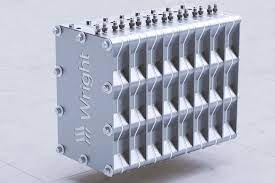Jeff Engler of Wright Electric wants it all. He wants lightweight, high-power electric motors and inverters to control them. He wants lightweight generators and now lightweight, high energy density batteries to store that electricity. He wants to meet the goal that, “By 2040, Wright will eliminate carbon emissions from all flights under 800 miles.” A more recent iteration of the company’s web site includes the goal of “Decarbonizing the industries that are hardest to decarbonize.”
These would seem heady ideals but Wright Electric seems to be making steady progress toward fulfilling those goals.
The Motor
Their motor has been tested to 1,000 kilowatts (1,340 horsepower), with expectations that it could reach 2,000 kW (2,680 hp.). According to Aviation Week, “The motor produced 1 megawatt of peak power on a dynamometer test stand at Wright’s facility in Albany, New York. The company has signed a Space Act Agreement with NASA to test the motor in an altitude chamber at the NASA Electric Aircraft Testbed (NEAT) in Sandusky, Ohio. The tests, up to a simulated altitude of 40,000 ft., are planned for late this year or early 2024.”
Engler looks beyond that success to the need to achieve four-to-five megawatts by stacking two motors on the same shaft, giving enough power to meet the needs of an ATR-size aircraft. Wright’s motors have achieved a power-to-weight ratio of 12 kilowatts per kilogram, and must have equally energy-dense components and batteries for successful large-scale flight. That the firm envisions BAE146 and C-130 size flight shows their long-term intent.

Wright Spirit, modified BAe 146, showing how Wright’s electric power unit (EPU) will be deployed on the aircraft. Illustration: Air and Cosmos
Wright’s web site shows a similar adaptation to a C-130’s turboprop engines.
The Batteries
Wright is targeting 1,000 Watt-hours per kilogram at the pack level, a little under four times that of the pack energy density of Tesla’s current efforts.
Wright’s press release on the subject explains, “. Such batteries would enable the electrification of hard-to-decarbonize transportation and mining sectors, for example electric aircraft with 100 passengers. Given that the vast majority of aerospace carbon emissions are in aircraft with 100 or more passengers, these batteries would enable a paradigm shift in decarbonization.”

Wright hopes to create battery with 4X energy density of today’s best packs
Colin Tschida, Head of Powertrain at Wright, says, “To cultivate a breakthrough in energy storage, we engaged four chemistry PhDs to act as scouts for promising battery chemistries. Wright also seeks collaboration with NASA, Y Combinator, The U. S. Department of Energy Advanced Research Projects Agency–Energy, and the US Department of Defense. This multi-pronged approach looks for answers in various approaches, including some not normally associated with such research.
Tschida adds, “This month, we are beginning our second phase of validation experiments with the approaches that showed the most promise.” Such research could least to breakthroughs in, “Lightweight thermally managed electric propulsion systems, something already part of Wright’s approach. It could also find ways of developing “Large molten battery packs,” according to Tschida.
“We have developed experience building and we see a way to apply that knowledge to the design of large molten battery packs,”
Wright works with leading groups such as NASA, Y Combinator, The US Department of Energy Advanced Research Projects Agency–Energy, and the US Department of Defense.
Wright’s willingness to explore different approaches and to collaborate with a variety of resources may help the firm become a leader in this emerging realm of flight.
